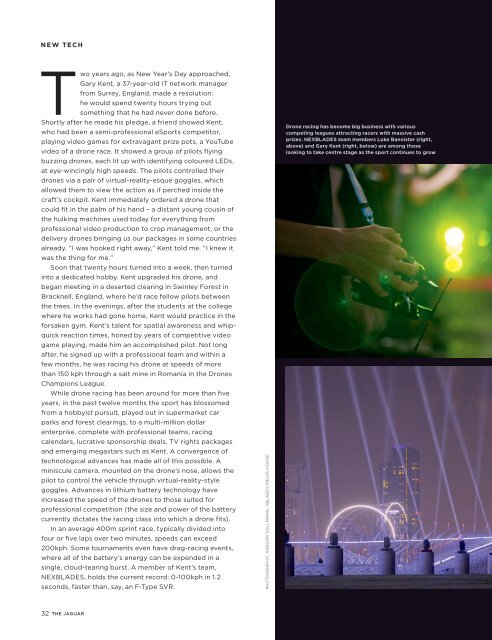You also want an ePaper? Increase the reach of your titles
YUMPU automatically turns print PDFs into web optimized ePapers that Google loves.
NEW TECH<br />
Two years ago, as New Year’s Day approached,<br />
Gary Kent, a 37-year-old IT network manager<br />
from Surrey, England, made a resolution:<br />
he would spend twenty hours trying out<br />
something that he had never done before.<br />
Shortly after he made his pledge, a friend showed Kent,<br />
who had been a semi-professional eSports competitor,<br />
playing video games for extravagant prize pots, a YouTube<br />
video of a drone race. It showed a group of pilots flying<br />
buzzing drones, each lit up with identifying coloured LEDs,<br />
at eye-wincingly high speeds. <strong>The</strong> pilots controlled their<br />
drones via a pair of virtual-reality-esque goggles, which<br />
allowed them to view the action as if perched inside the<br />
craft’s cockpit. Kent immediately ordered a drone that<br />
could fit in the palm of his hand – a distant young cousin of<br />
the hulking machines used today for everything from<br />
professional video production to crop management, or the<br />
delivery drones bringing us our packages in some countries<br />
already. “I was hooked right away,” Kent told me. “I knew it<br />
was the thing for me.”<br />
Soon that twenty hours turned into a week, then turned<br />
into a dedicated hobby. Kent upgraded his drone, and<br />
began meeting in a deserted clearing in Swinley Forest in<br />
Bracknell, England, where he’d race fellow pilots between<br />
the trees. In the evenings, after the students at the college<br />
where he works had gone home, Kent would practice in the<br />
forsaken gym. Kent’s talent for spatial awareness and whipquick<br />
reaction times, honed by years of competitive video<br />
game playing, made him an accomplished pilot. Not long<br />
after, he signed up with a professional team and within a<br />
few months, he was racing his drone at speeds of more<br />
than 150 kph through a salt mine in Romania in the Drones<br />
Champions League.<br />
While drone racing has been around for more than five<br />
years, in the past twelve months the sport has blossomed<br />
from a hobbyist pursuit, played out in supermarket car<br />
parks and forest clearings, to a multi-million dollar<br />
enterprise, complete with professional teams, racing<br />
calendars, lucrative sponsorship deals, TV rights packages<br />
and emerging megastars such as Kent. A convergence of<br />
technological advances has made all of this possible. A<br />
miniscule camera, mounted on the drone’s nose, allows the<br />
pilot to control the vehicle through virtual-reality-style<br />
goggles. Advances in lithium battery technology have<br />
increased the speed of the drones to those suited for<br />
professional competition (the size and power of the battery<br />
currently dictates the racing class into which a drone fits).<br />
In an average 400m sprint race, typically divided into<br />
four or five laps over two minutes, speeds can exceed<br />
200kph. Some tournaments even have drag-racing events,<br />
where all of the battery’s energy can be expended in a<br />
single, cloud-tearing burst. A member of Kent’s team,<br />
NEXBLADES, holds the current record: 0-100kph in 1.2<br />
seconds, faster than, say, an F-Type SVR.<br />
PHOTOGRAPHY: ANSGAR SOLLMANN, XBLADES MEDIA HOUSE<br />
Drone racing has become big business with various<br />
competing leagues attracting racers with massive cash<br />
prizes. NEXBLADES team members Luke Bannister (right,<br />
above) and Gary Kent (right, below) are among those<br />
looking to take centre stage as the sport continues to grow<br />
32 THE JAGUAR



